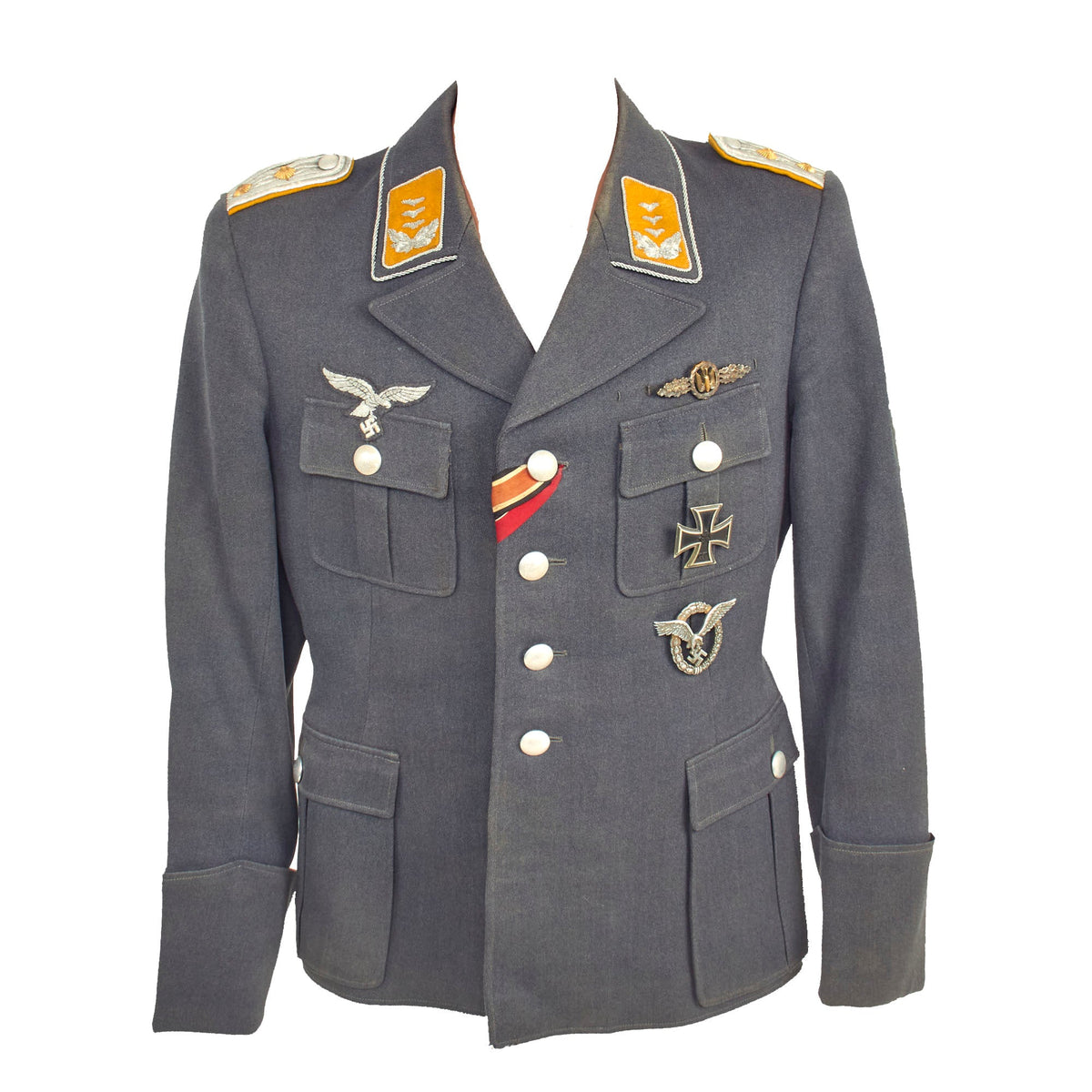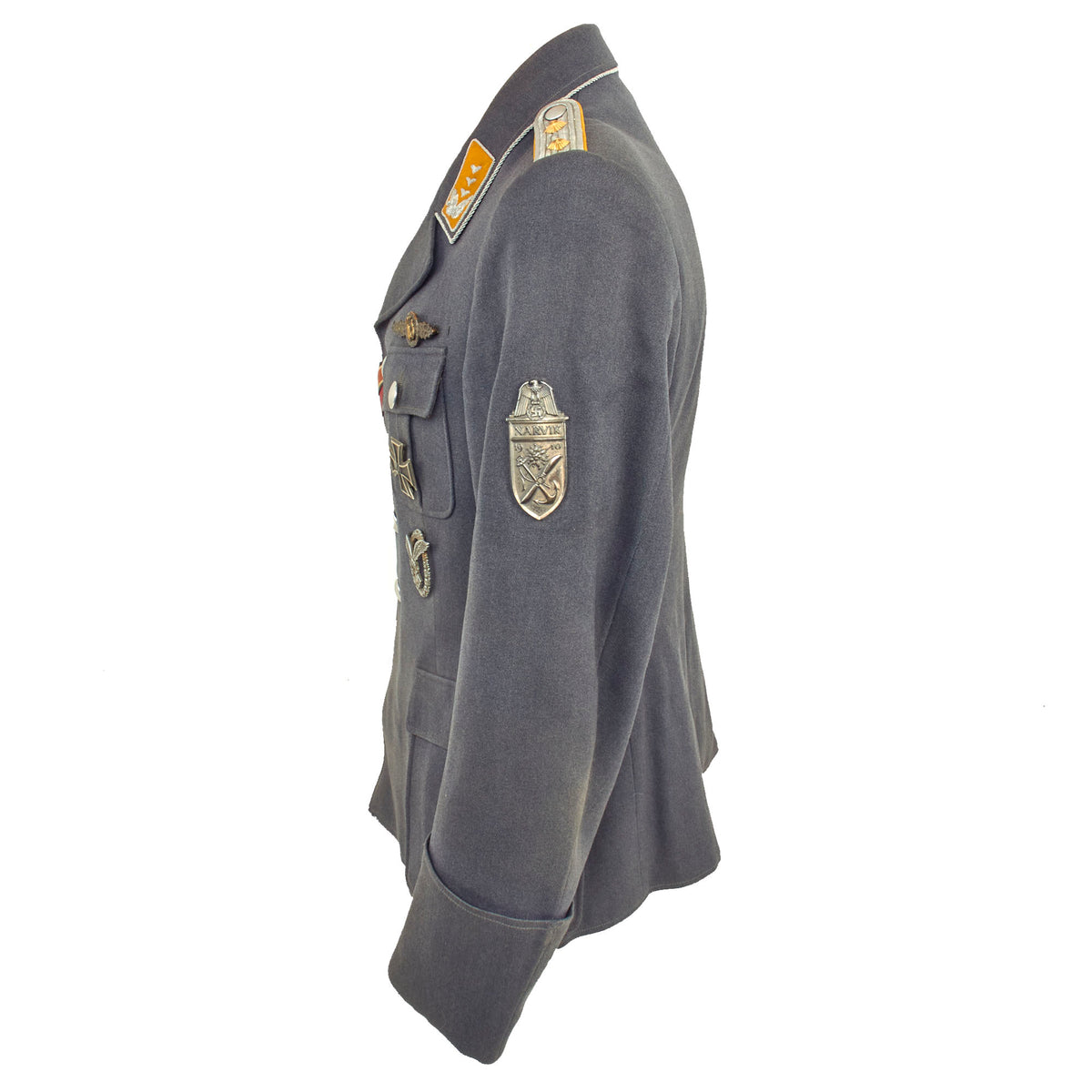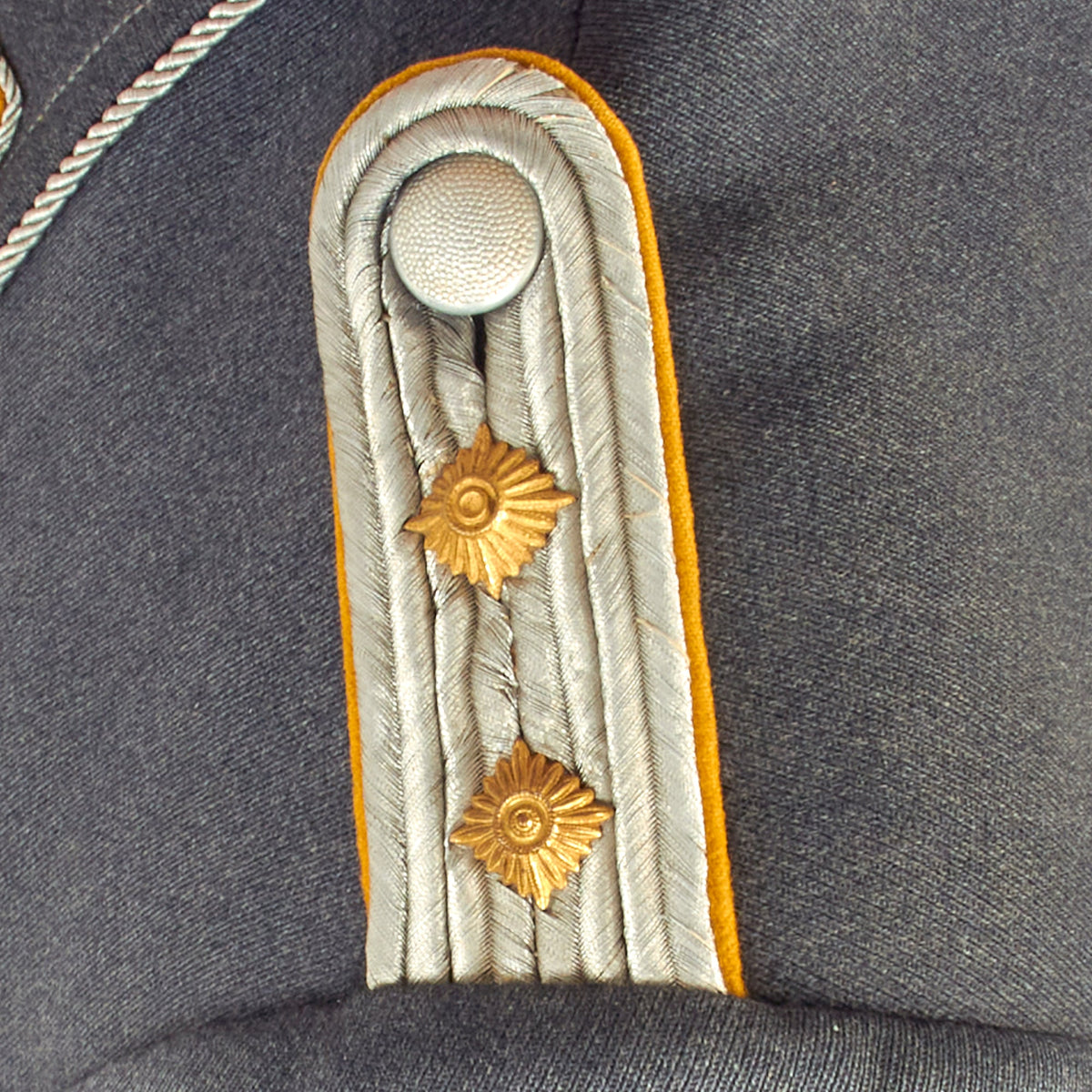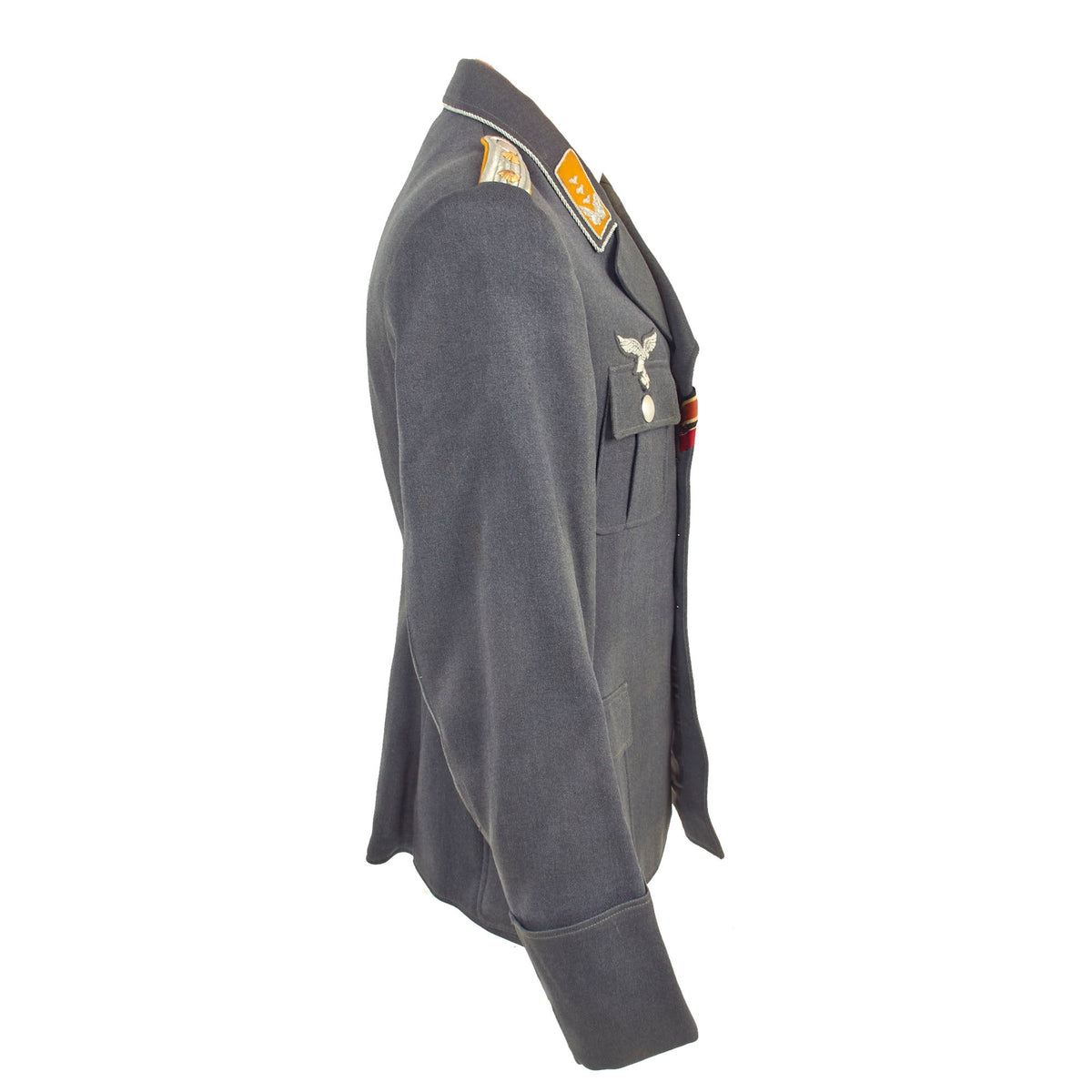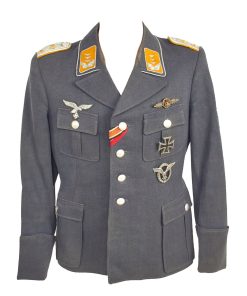Original German WWII Luftwaffe Junkers Ju 88 Pilot Hauptmann Hans Wachholz Named Uniform Tunic, Award & Document Grouping Original Items
$ 3.995,00 $ 998,75
Original Item: Only One Available. This is an incredible German WWII Luftwaffe grouping, the likes of which we rarely get to see! This great grouping is named to Hans Wachholz, a member of the Luftwaffe who rose through the ranks from an NCO to attain the officer rank of Hauptmann (Captain), and was a pilot of the Junkers Ju 88 Bomber. It includes his Flight Blouse Tunic, various awards, identification and award documents, and even some historical information in the included binder. If you looking for a great fully researched Luftwaffe pilot grouping for your collection, this is it!
The centerpiece of this collection is a fantastic WWII German Luftwaffe Flight Branch Officer Four Pocket Fliegerbluse (Flight Blouse) Service Tunic, tailor made with an intact maker tag on the inside of the left breast. This reads as follows:
C. Louis Weber
feine
Uniform-Maßschneiderei
Hannover
Additionally, the inside of the pocket still has the original C. Louis Weber tailor name tag, which gives a date of 8. 12. 39. and the last name Wachholz, with an unclear abbreviation before it. The tunic is in very good / excellent condition, especially considering the long service it saw during the war. This great piece is produced in Luftwaffe blue grey wool and shows only only light wear and fading from use, especially around the collar. All buttons are bright finished pebbled aluminum and back marked. The pockets are all squared, and the front closure features 4 buttons, all sewn directly to the tunic. The right breast of the uniform has a correct early “Droop-Tail” bullion embroidered officers eagle sewn in place with the correct stitching pattern. It is only stitched to the outer layer of fabric, so it is the original eagle installed on this uniform tunic.
The collar of this officer’s tunic has a twisted bullion border, correct for a Luftwaffe officer’s fliegerbluse. The attached Kragenpatten (Collar Flaps) are in Goldgelb (Gold-Yellow), the correct Waffenfarbe (Corps Color) for Aviator troops such as pilots and ground personnel, as well as Fallschirmjäger (parachute troops). The sew-in style Schulterklappen (Shoulder Boards or Epaulettes) have the same color piping, and have four rows of silver “Russia Braid” around the edge with two “Pips” added, indicating the rank of Hauptmann (Captain). This is confirmed by the collar insignia, which each show three “gull wing” insignia over a wreath. The left sleeve is adorned with a rare Luftwaffe Narvik Shield, which is correctly installed with the fabric backing sewn over the metal backing plate on the interior of the sleeve.
The top buttonhole on the tunic the tunic has the ribbons for an Iron Cross 1939 2nd Class and Eastern Front medal installed. Above the left pocket are thread loops, which could be used to attach a ribbon bar, but in this case there is a Luftwaffe Silver Grade Front Flying Clasp for Bombers marked on the back with R.S. for Rudolf Souval, awarded for 60 missions. Below this, attached to more thread loops, is a very good condition slightly vaulted Iron Cross 1939 First Class award, which is unmarked. The award below this is a great Luftwaffe Combined Pilot / Observer Badge (Flugzeugführer- und Beobachterabzeichen), aluminum construction with much of the gold wash on the wreath still intact. It is maked on the back with the “Barred A” trademark of F. W. Assmann & Söhne of Lüdenscheid, a large maker of belts, buttons, and other accoutrements
The interior of the tunic is lined in fine blue gray rayon, and does show some light wear. There are no markings that we can see aside from the maker mark, indicating that it was a bespoke example made for this specific officer, not one issued through military channels. There is some fraying of the lining around the seam areas, some of which have pulled out a bit. Some of the stitching at the edge along the front closure has also pulled as well. It features an internal belt for a more form fitting appearance. The sleeves are lined with striped fabric, standard for the period. There is the correct hanger strap next to the outlet for the left lower pocket to hang a dagger.
Overall exterior condition is excellent, showing only light wear from service. It is remarkably well preserved considering how long it served Wachholz. We cannot see any real mothing, and the colors are vibrant and well retained. Some of the stitching is loose, such as on the collar piping, but that it to be expected after so much use. The Bullion is still bright, and the buttons are lovely. Really a choice example here!
The included documents tell much of the story of Wachholz’s service during the pre-war and wartime period. They include award certificates or photocopies for the Wehrmacht Long Service Award 4th class, Luftwaffe Pilot’s Badge, Sudetenland Medal, Luftwaffe Combined Pilot / Observer badge, Narvik Shield, and Eastern Front Medal. There is also an ID card with a photograph of Wachholz, an official order, and some other material. There is also a typed history of what we know of his service. Please see the photographs for scanned details.
A fantastic researched Ju 88 Bomber pilot’s grouping, complete with lots of documentation and ready to display!
Approx. Measurements:
Collar to shoulder: 9.5″
Shoulder to sleeve: 25.5”
Shoulder to shoulder: 16”
Chest width: “18.5
Waist width: 17.5″
Hip width: 20.5”
Front length: 28″
The Junkers Ju 88 is a German World War II Luftwaffe twin-engined multirole combat aircraft. Junkers Aircraft and Motor Works (JFM) designed the plane in the mid-1930s as a so-called Schnellbomber (“fast bomber”) that would be too fast for fighters of its era to intercept. It suffered from technical problems during its development and early operational periods but became one of the most versatile combat aircraft of the war. Like a number of other Luftwaffe bombers, it served as a bomber, dive bomber, night fighter, torpedo bomber, reconnaissance aircraft, heavy fighter and at the end of the war, as a flying bomb.
Despite a protracted development, it became one of the Luftwaffe’s most important aircraft. The assembly line ran constantly from 1936 to 1945 and more than 15,000 Ju 88s were built in dozens of variants, more than any other twin-engine German aircraft of the period. Throughout production the basic structure of the aircraft remained unchanged.
The Luftwaffe, the air force of the German military during the Third Reich, was established in 1935. Over the next 10 years, Luftwaffe troops wore a huge variety of uniforms. Enlisted men generally wore uniforms issued from military depots. Most enlisted soldiers had wool trousers and a short jacket with two internal lower pockets, called a Fliegerbluse, as well as a dressier 4-pocket tunic, the Tuchrock. Officers wore the same general uniform styles, but as officers had to supply their own uniforms, they usually wore tailor made versions. There were also myriad varieties of specialized uniforms worn by certain units or in specific situations, from the tuxedo-style “gala” formal wear uniform of the pre-war period, to the plain coveralls worn by crews of anti-aircraft cannons. There were work uniforms, tropical and summer uniforms, and camouflage clothing for airborne troops and other Luftwaffe soldiers in ground combat. Flight crews had their own specialized gear, including leather jackets and warm, electrically heated suits. Most but not all Luftwaffe uniform jackets bore the Luftwaffe emblem of a flying eagle holding a swas.
Fast Shipping with Professional Packaging
Thanks to our longstanding association with UPS FedEx DHL, and other major international carriers, we are able to provide a range of shipping options. Our warehouse staff is expertly trained and will wrap your products according to our exact and precise specifications. Prior to shipping, your goods will be thoroughly examined and securely secured. We ship to thousands clients each day across multiple countries. This shows how we're dedicated to be the largest retailer on the internet. Warehouses and distribution centres can be located throughout Europe as well as the USA.
Note: Orders with more than one item will be assigned a processing date depending on the item.
Before shipping before shipping, we'll conduct a thorough inspection of the items you have ordered. Today, the majority of orders will be delivered within 48 hours. The delivery time will be between 3-7 days.
Returns
The stock is dynamic and we cannot completely manage it because multiple stakeholders are involved, including our factory and warehouse. So the actual stock may alter at any time. It's possible that you may not receive your order once the order has been made.
Our policy is valid for a period of 30 days. If you don't receive the product within 30 days, we are not able to issue a refund or an exchange.
You can only return an item if it is unused and in the same state as the day you received it. You must have the item in its original packaging.
Related products
Uncategorized
Uncategorized
Uncategorized
Uncategorized
Uncategorized
Uncategorized
Uncategorized
Uncategorized
Armoured Fighting Vehicles of the World: AFVs of World War One (Hardcover Book) New Made Items
Uncategorized
Uncategorized
Uncategorized
Uncategorized
Uncategorized
Uncategorized
Uncategorized
Uncategorized
Uncategorized
Armored Burgonet Helmet & Polearm from Scottish Castle Leith Hall Circa 1700 Original Items
Uncategorized
